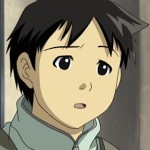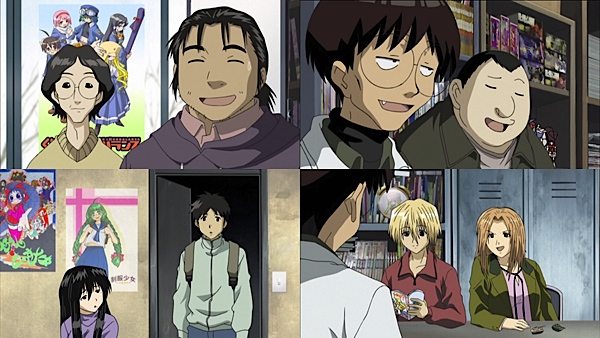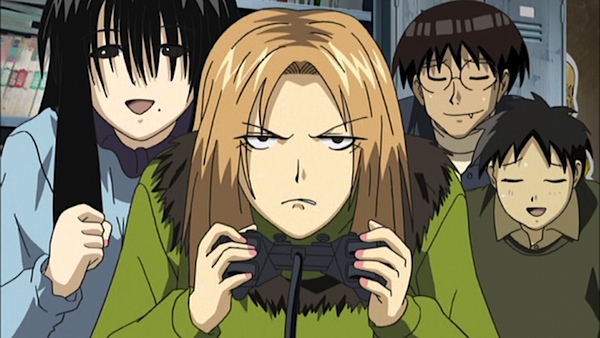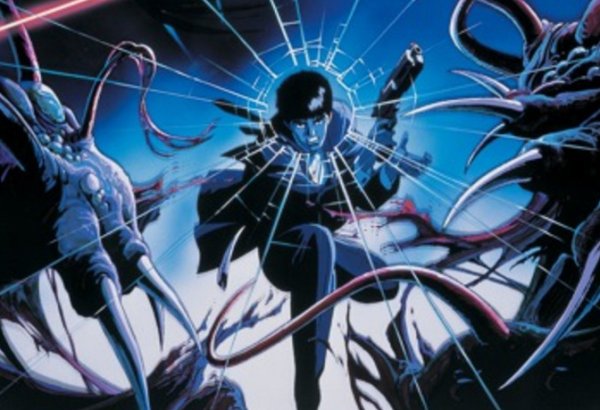
Shimoku Kio’s love letter to the otaku masses.
In April 2002, Kio began a manga about a college club whose members were interested in anime, manga, and games, the Gendai Shikaku Bunka Kenkyuukai, the Society for the Study of Modern Visual Culture. This was not simply an anime club or a manga club or a gaming club. This was a group whose purpose was to explore and enjoy all aspects of what we can call Japanese otaku culture. The title “Genshiken” comes from a shorthand for the club’s rather lengthy name. In 2004, the property was turned into an anime with animation by Studio Palm.

The story is told through the eyes of Kanji Sasahara, a new freshman at the fictional Shiiou University (based somewhat on the real Chuo University in Tokyo), where on club recruitment day he decides to join the Genshiken. Sasahara has long been interested in otaku culture, but somewhat ashamed to publicly reveal that. Now, falling in with the members of Genshiken, who are quite open and forthright about their love for anime, manga, games, and all other aspects of the culture, he begins to break free of his reservations and embrace his interests. The twelve episodes of the first season all have rather long and academic-sounding titles, most likely reflecting the chapter titles of the mysterious First Club President’s thesis (his real name is never revealed; after he graduates and moves on, the episode titles become more pedestrian).
The broad range of otaku types are represented by the various members: Makoto Kohsaka is the ultimate gamer; Souichirou Tanaka is into cosplay costume design and plastic model building; Mitsunori Kugayama is a manga artist, mainly drawn to making erotic doujinshi; Kanako Ohno is the first fujoshi to join the club, with a particular liking for bald, middle-aged men, though she is also an avid and passionate cosplayer, which understandably links up with Tanaka’s interests right away; Harunobu Madarame is perhaps the most hardcore otaku of the group, reveling in his lifestyle of spending all of his money on otaku goods. Sasahara is an Everyman character and as such has broad interests in the various different subcultures of the subculture. In stark contrast to all of the otaku, the club acquires one “normal” character, Saki Kasukabe, who enters into the Genshiken orbit only because she hooks up with Kohsaka, whose good looks attracted her before she learned about his otaku personality. She provides the constant foil to the otaku sensibilities of the club’s members, leading to amusing incidents.

There is no real “plot” to describe. Genshiken is largely the everyday, slice-of-life interactions of the club members and a loving look at the subculture and all of its various branches, most of them noted previously with the individual members’ interests. Of course, there are regular trips to Akihabara, the central marketplace for all things otaku, as well as regular pilgrimages to Comifes, the fictional counterpart to the real Comic Markets (Comiket), the twice-a-year conventions where doujinshi (self-published fan comics) are sold. If one knew nothing about otaku culture at all and wanted a relatively broad introduction to it, watching the first season of Genshiken would provide a fairly comprehensive introduction.
The show is not, however, a documentary nor an attempt to provide some record of the culture. It is more a celebration sprinkled with wry humor and the occasional dollop of satire, as Kio is not afraid of poking fun at fan stereotypes–and realities–while also acknowledging some of the less than praiseworthy aspects involved in the otaku lifestyle. The extremes that some of the members will go to in order to feed their craving (especially memorable was Madarame’s refusal to leave Comifes and seek treatment when his hand was seriously injured, all because he wanted to make sure he bought all the doujinshi he desired) are shown as gentle farce, but with an undercurrent of admonition. It’s funny because it’s true, but it’s a little scary because it’s true.

If one would want to point to a general theme for the first season, it would be that there is no reason to feel ashamed of one’s hobbies and interests. Sasahara’s slow emergence into embracing his interests is portrayed in a positive light, as the voice of mainstream derision, Saki, may be dismissive of the culture and its adherents, but never engages in a full-scale attack upon it. It is, in its way, a celebration of the culture, but Genshiken, thankfully, is not outright pandering towards the fandom, such as happens in some later shows such as Oreimo, where even some of the more…disturbing…elements are vigorously defended by the main character (to the point of his engaging in special pleading on more than one occasion). There is a more laid-back, ironic strain to Genshiken’s view on otaku culture. For some of the more…disreputable…aspects, what it puts forward is the idea of tolerance. In fact, one of the main messages that comes out of the show is an appeal for tolerating differences that the fandom could do well to embrace, instead of the usual division and constant sniping that exists among real-life fans, especially on the internet. In that sense, the members of the Genshiken are an idealistic portrayal of what the fandom could and should be, not the sad reality of what it is. This message of tolerance and acceptance is a key theme throughout the entire run of all three seasons of the show, as the first series was followed by three OVAs, a second full season series (Genshiken 2) and the most recent follow up called, slightly confusingly, Genshiken Second Season in English (Genshiken Nidaime).

Though it may have run ten years ago, Genshiken still speaks to the current state of fandom on many levels. Its message of tolerance and acceptance of oneself and one’s interests continues to hold important truths even today. Certain aspects might appear slightly dated, though the “show within the show” which the members of the club eagerly follow, Kujibiki Unbalance (KujiAn, of which three representative episodes, the opener, a recap, and the season finale, were fully animated; it should not be confused with the later, and much inferior, Kujibiki Unbalance TV full season series), provides a satirical look at certain trends within anime at the time that have stayed into the present time.
Though many things have changed and it took some time for Kio to include more recent trends in the manga (while Ohno certainly is a fujoshi, it’s only with the appearance of Chika Ogiue (who makes her first anime appearance in the OVAs) and then the later takeover of the club by fujoshi in the Nidaime generation that the current strength of the female “rotten girl” demographic segment of the fandom gets attention on the level that matches their buying power and influence on what gets made), the show holds up surprisingly well and still provides a window on the crazy loons who make up the fandom for modern Japanese visual culture.




